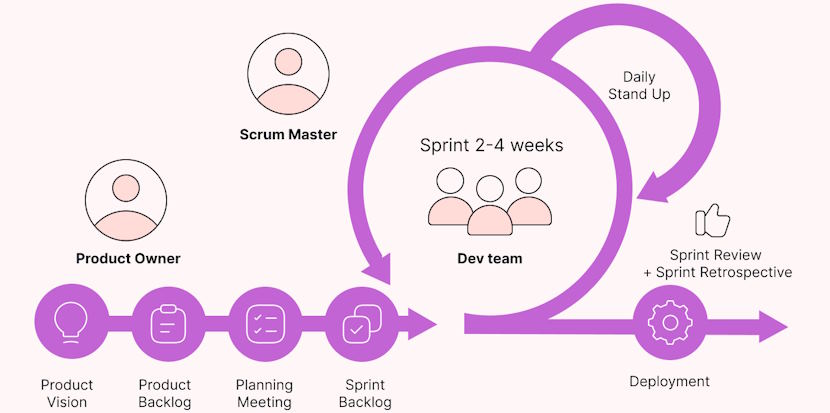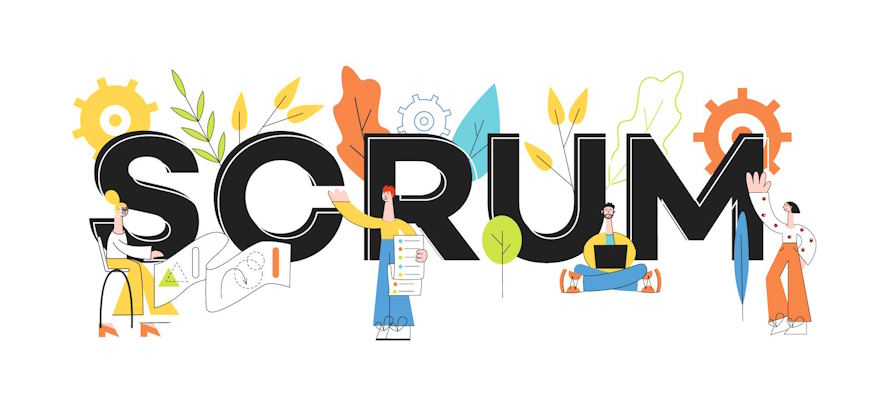Understanding Scrum is already a necessity for modern project management. This methodology promotes agility, efficiency, and collaboration, making it an invaluable tool in today’s fast-paced business environment. That’s why we bring you our Introduction to Scrum, laid out in simple language and accessible even to beginners. We are confident that everyone who becomes familiar with Scrum roles and responsibilities will become a close friend.
What is Scrum?
Scrum is an agile methodology for managing complex projects, especially in software development. It originated in the early 1990s and was created by Jeff Sutherland and Ken Schwaber, who sought to improve productivity and adapt to changing project requirements. The core principles of Scrum are transparency, validation, and adaptation, which foster an environment of continuous improvement. Scrum is built on core values such as commitment, courage, focus, openness, and respect, which guide teams to create high-quality products.
Key Roles in Scrum
Key roles in Scrum include 3 main positions:
1. Scrum Master
The Scrum Master is a team facilitator and coach who ensures everyone follows Scrum practices. Their responsibilities include removing obstacles, fostering a culture of continuous improvement, and protecting the team from external disruptions. Effective Scrum masters must have strong communication skills, empathy, and a deep understanding of Scrum principles.

2. Product Owner
The product owner is responsible for defining and prioritizing the product backlog, which lists all the tasks and functions required for the product. They act as the main liaison between the stakeholders and the development team, ensuring that the project meets the business goals and user needs. Therefore, product owners must be able to balance the stakeholders’ interests and have a clear vision for the product.
3. Development team
The development team consists of professionals who work together to deliver a potentially shippable product at the end of each sprint. This cross-functional team includes people with different skills needed to accomplish the project tasks, such as developers, testers, and designers. The team’s self-organizing nature allows it to effectively manage its work and collaborate.
Scrum Ceremonies
Now, let’s walk through the basic Scrum ceremonies.
Sprint planning starts each sprint by defining what the team wants to accomplish. In this meeting, the product owner presents the highest priority items from the product backlog, and the team discusses the tasks they can achieve during the sprint and commits to accomplishing them. Effective sprint planning requires clear communication and realistic goal setting.
A daily scrum (standup) is a short, time-limited meeting where team members share their progress, plans for the day, and obstacles they have encountered. This meeting helps maintain consistency and transparency within the team. For it to be productive, participants should focus on concise and relevant updates.

At the end of each sprint, the team conducts a Sprint Review to show stakeholders the completed work. This meeting provides feedback and ensures the product evolves to meet user needs and business goals. Involving stakeholders in the review helps align expectations and fosters collaboration.
A sprint retrospective is a reflective meeting where the team discusses what was done well, what could be improved, and how to implement those improvements in the next sprint. This ceremony is critical to continuous improvement, allowing the team to adapt and improve their processes. Meaningful retrospectives require honesty and a commitment to development.
The Scrum Process
Scrum takes an iterative and incremental approach to project management. A typical sprint cycle begins with sprint planning, followed by a series of daily scrums. The team works through the tasks, aiming to release a potentially shippable incremental product by the end of the sprint. After a review of the sprint that showcases the increment, the team conducts a sprint retrospective to analyze their work and plan improvements.
This iterative cycle has several advantages. It allows teams to respond quickly to changes, provides regular opportunities for feedback, and ensures that the product evolves through continuous improvement. By breaking the project into manageable chunks, teams can create value incrementally, reducing risk and increasing agility. This is what the Scrum process is all about.
